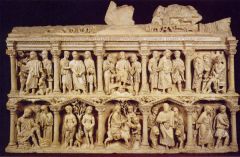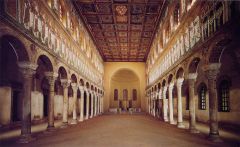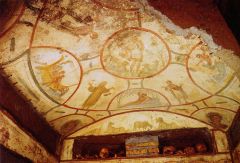![]()
![]()
![]()
Use LEFT and RIGHT arrow keys to navigate between flashcards;
Use UP and DOWN arrow keys to flip the card;
H to show hint;
A reads text to speech;
22 Cards in this Set
- Front
- Back

|
St. Apolinare Nuovo, 350 ce, Late Antiquity
in Ravenna, classical columns, mosaic instead of frieze though one side has female martyrs/saints and other side has males. Jesus is at the end wearing purple and gold (roman emperor colors) Mary is at end of women, women coming from port of ravenna, men from palace, ties the church with the area etc. clerestory between windows there are little bible scenes, focused on life of jesus at the end of this period, Jesus is becoming more of a figure of divinity and imperial being as opposed to just a humble, man/teacher |
|
|
Catacomb, 350, Late Antiquity
most of the early christian art was in the catacombs, hidden underground because they weren't allowed to practice before edict of milan |

|
|
|
Christ before Pilate, 350, Late Antiquity
from the Rossano Gospels Shows two distinct levels, separating the people spatially and by temporally has Pilate seated in a roman style and all of it is arranged in an apse like shape |

|
|
|
Christ as the Good Shephard, 350, Late Antiquity
relates to the calf-bearer (votive, big eyes, offering) But because jesus is not in prayer/awe position, shows that it's not a votive because he is not protecting the lamb, he is offering it, we can see that it is post edict of milan classical form, simple tunic, long hair |

|
|
|
Dura Europos, 350, Late Antiquity
"Finding Baby Moses" narrative is all at once, not clear, no gesture, very static one of few figural jewish art pieces |

|
|
|
Dura Europos, 350, Late Antiquity
"The Golden Calf" Meant to be didactic, really not much left, not clear story, very static |

|
|
|
Dura Europos, 350, Late Antiquity
Synagogue, found in Syria, lots of panels, with different stories |

|
|
|
Sarcophagus of the Good Shephard, 350, Late Antiquity
horror vacuii, tons of different ground lines, putti all around climbing the vines/branches/GRAPES making wine out of grapes 3 good shepherds because holy trinity 2 on left are looking right, right looking left because if the center one was looking at us, it would take on more power than the other two also, jesus's beards diff on each, none=jesus, most=god wine=blood, eucharist relates back to the roman sarcophagi with Wine (offering for the greeks) and with the baccus, dionysus (roman) |

|
|
|
Three Hebrew Youths in the Fiery Furnace, 350, Late Antiquity
typology, because they a typical jewish image and they added a dove, and the dove is the holy spirit, way for the christians to hide when they were being persecuted, looked like jewish art also, connects them to an established religion, says hey we aren't so different, just an expansion |

|
|
|
Lazarus, 350, Late Antiquity
Jesus revives Lazarus from the dead, new testament story because this is before the edict of milan only uses image signs, have to know more of the story to understand, focus on Jesus's gesture, size, shows his importance, has a magic wand and we see him as a miracle worker All about RESSURECTION, the stories were all chosen from the new testament to do their best to support christian ideas. |

|
|
|
Galla Pacidia, 350, Late Antiquity
mosaic in Ravenna mausoleum mosaic of good shepherd, has halo, multiple sheep, expanded narrative, royal colors, worship out in open now holding a gold cross like a staff as opposed to a shepherd's staff mosaics no longer on ground, like in roman times part of architectural form, draws eye around |

|
|
|
Galla Placidia, 350, Late Antiquity
central greek cross plan, mausoleum each arm of cross has a mosaic |

|
|
|
Old St. Peter's, 350, Late Antiquity
draws from roman basilica, built on peter's grave one directional focus, all to apse, nave with side aisles transcepts create more space for people near apse very simple outside, beautiful inside. |

|
|
|
Orant Figure, 350, late Antiquity
form is not important, more about gesture/message looking up at god in prayer |

|
|
|
Santa Costanza, 350, Late Antiquity
baptistry/mausoleum (circular= circle of life) circular, like the roman circular temples, this one is devoted to a woman dome with barrel vaulted ambulatory around the ceiling has mosaics of putti inside again outside=plain, inside= elaborate (body and soul) |

|
|
|
Santa Costanza, 350, Late Antiquity
|

|
|
|
Santa Sabina, Late Antiquity, 350
half classical, half new style, half basilican, half centralized |

|
|
|
Sarcophagus of a Philosopher, 350, Late Antiquity
Orant position=old/new testament jesus is being baptized on the right, dove above them jonah and the whale on left the philosopher is in the middle, pulls on roman pagan art which often included philosophers (honors wisdom and old age especially after death) 5 different scenes all at once but only snippets of stories, image signs eclectic in nature: roman pagan, old testament, christianity |

|
|
|
Sarcophagus of Junius Bassus, 350, Late Antiquity
after edict, inscription on top says that he was baptized on death bed, middle top shows Jesus giving laws/keys to Peter and Paul, he is stepping on Atlas, pulling from past language because that also appears on Augustus's chest plate shows christianity as a powerful force, jesus is enthroned as law maker/emperor lots of registers with stories, not about bodies, not classical, just about the identities/stories style is very late roman with big heads chose stories that related to salvation |

|
|
|
St. Apolinare Nuovo, 350 ce, Late Antiquity
in Ravenna, classical columns, mosaic instead of frieze though one side has female martyrs/saints and other side has males. Jesus is at the end wearing purple and gold (roman emperor colors) Mary is at end of women, women coming from port of ravenna, men from palace, ties the church with the area etc. clerestory between windows there are little bible scenes, focused on life of jesus at the end of this period, Jesus is becoming more of a figure of divinity and imperial being as opposed to just a humble, man/teacher |

|
|
|
The Good Shepherd Mosaic, 350, Late Antiquity
in the catacomb of St. peter and Marcellinus Jesus is in the center as the good shepherd, four lunettes around telling the story of Jonah and the whale: typology, chose a story about salvation, says "if you stick with it, jesus will save you" uses just image signs very sparse imagery orant figures too |

|
|
|
Old Farmer of Corycus, 350 Late Antiquity
reminiscent of old roman landscapes early latin manuscript |

|

